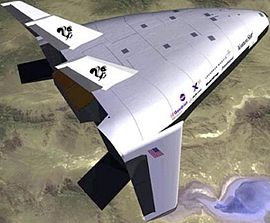Lockheed Martin X-33

Simulated in-flight view of the X-33
|
|
| Function | Unmanned re-usable spaceplane technology demonstrator |
|---|---|
| Manufacturer | Lockheed Martin |
| Country of origin | United States |
| Project cost | $922 million NASA + $357 million Lockheed Martin |
| Size | |
| Height | 20 m (69 ft) |
| Diameter | N/A |
| Mass | 285,000 lb (130,000 kg) |
| Stages | 1 |
| Capacity | |
| Launch history | |
| Status | Canceled (2001) |
| Total launches | 0 |
| First stage - X-33 | |
| Engines | 2 XRS-2200 Linear Aerospikes |
| Thrust | 410,000 lbf (1.82 MN) |
| Fuel | LOX/LH2 |
The Lockheed Martin X-33 was an unmanned, sub-scale technology demonstrator suborbital spaceplane developed in the 1990s under the U.S. government-funded Space Launch Initiative program. The X-33 was a technology demonstrator for the VentureStar orbital spaceplane, which was planned to be a next-generation, commercially operated reusable launch vehicle. The X-33 would flight-test a range of technologies that NASA believed it needed for single-stage-to-orbit reusable launch vehicles (SSTO RLVs), such as metallic thermal protection systems, composite cryogenic fuel tanks for liquid hydrogen, the aerospike engine, autonomous (unmanned) flight control, rapid flight turn-around times through streamlined operations, and its lifting body aerodynamics.
Failures of its 21-meter wingspan and multi-lobed, composite material fuel tank during pressure testing ultimately led to the withdrawal of federal support for the program in early 2001. Lockheed Martin has conducted unrelated testing, and has had a single success after a string of failures as recently as 2009 using a 2-meter scale model.
In 1994 NASA initiated the Reusable Launch Vehicle (RLV) program, which among other things lead to the development of the X-33 within a few years. Another important vehicle in this program was the Orbital Sciences X-34, which was developed concurrently with the X-33 by 1996. Goals of the RLV program:
The X-33 was by 1996, and 1 billion was spent through 1999 with about 80 percent coming from NASA and additional money contributed by private companies. The goals was to have a first flight by 1999, and operating space vehicle by 2005.
.. to build a vehicle that takes days, not months, to turn around; dozens, not thousands, of people to operate; with launch costs that are a tenth of what they are now. Our goal is a reusable launch vehicle that will cut the cost of getting a pound of payload to orbit from $10,000 to $1,000.
...
Wikipedia
